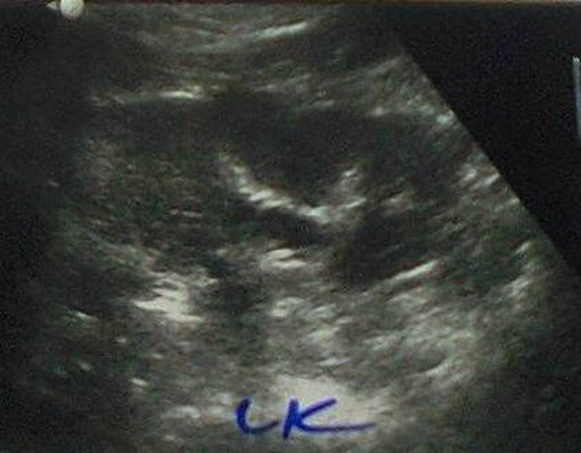Research Article | DOI: https://doi.org/10.58489/2836-8959/007
The novel occurrence of non-syndromic unilateral renal hypoplasia and unilateral aplasia in two brothers
- Aamir Jalal Al-Mosawi 1
1 Advisor in Pediatrics and Pediatric Psychiatry Children Teaching Hospital of Baghdad Medical City and the National Center of Training and Development
*Corresponding Author: Aamir Jalal Al-Mosawi
Citation: Aamir Jalal Al-Mosawi, The novel occurrence of non-syndromic unilateral renal hypoplasia and unilateral aplasia in two brothers. Journal of Clinical Sciences and Clinical Research.2(1). DOI: 10.58489/2836-8959/007
Copyright: © 2023 Aamir Jalal Al-Mosawi, this is an open access article distributed under the Creative Commons Attribution License, which permits unrestricted use, distribution, and reproduction in any medium, provided the original work is properly cited.
Received: 03 March 2023 | Accepted: 08 March 2023 | Published: 10 March 2023
Keywords: Autosomal dominant; non-syndromic; unilateral renal hypoplasia; unilateral renal aplasia Iraq
Abstract
Background: Non-syndromic unilateral renal hypoplasia is a congenital condition associated with one small kidney (hypoplastic) that generally has normal residual parenchyma but smaller calyces. We have previously reported the first case of non-syndromic unilateral renal hypoplasia transmitted in an autosomal dominant fashion from the mother.
Patients and methods: The brother of the boy who was the patient in the medical literature reported to have unilateral renal hypoplasia transmitted from the mother in an autosomal dominant was seen and renal ultrasound performed.
Results: The present patient, the brother was seen late during June, 2022 at about the age of eighteen years, for a routine check and was asymptomatic and otherwise healthy. However, abdominal ultrasound showed unilateral right renal aplasia. The right kidney was absent, while left kidney showed compensatory hypertrophy.
Conclusion: This paper reports the novel occurrence of non-syndromic unilateral renal hypoplasia and unilateral aplasia in two brothers.
Introduction
Non-syndromic unilateral renal hypoplasia is a rare congenital condition associated with one small (hypoplastic) kidney that generally has normal residual parenchyma but smaller calyces. The size of the hypoplastic kidney is less than two standard deviations below the expected mean. The condition can be asymptomatic or presents with urinary tract infections and/or renal urolithiasis. Unilateral renal hypoplasia is typically diagnosed with renal ultrasound.
We have previously reported the first case of non-syndromic unilateral renal hypoplasia transmitted in an autosomal dominant fashion from the mother [1].
Patients and methods
The brother of the boy who was the patient in the medical literature reported to have unilateral renal hypoplasia transmitted from the mother in an autosomal dominant was seen and renal ultrasound performed.
Results
The present patient, the brother was seen late during June, 2022 at about the age of eighteen years, for a routine check and was asymptomatic and otherwise healthy. However, abdominal ultrasound showed unilateral right renal aplasia. The right kidney was absent. The left kidney showed compensatory hypertrophy with dimensions of 10 x 5 cm, cortex 14 mm with homogeneous texture. The cortico-medullary junction was intact with no mass or stone. There was no dilatation of the pelvi-calyceal system or the left ureter. There was no other abnormality on abdominal ultrasound.
Discussion
The occurrence of non-syndromic unilateral renal hypoplasia has been reported early during the 1900s [1]. Taño Pino et al (1996) described two brothers, not twins who had unilateral congenital renal hypoplasia with vesico-urethral reflux. The diagnosis in the two brothers was made at about the age of 24 years and without any urological history, when they presented with a dysuria-pollakiuria syndrome [3].
Cain et al (2010) emphasized a genetic basis for unilateral renal hypoplasia [4], but the transmission of the condition from a parent to offspring has never been reported. Autosomal dominant non-syndromic unilateral renal hypoplasia has not been reported in Iraq or in any other country [3-9].
The occurrence of non-syndromic isolated unilateral renal aplasia in two siblings has been reported once during the early 1960s.
Conclusion
This paper reports the novel occurrence of non-syndromic unilateral renal hypoplasia and unilateral aplasia in two brothers.
References
- Al-Mosawi AJ. (2020) Autosomal dominant non-syndromic unilateral renal hypoplasia: A condition not previously reported in the literature. International Journal of Radiology Research (e-ISSN: 2663-4562, p-ISSN: 2663-4554) Jul; 2(1): 18-19.
View at Publisher | View at Google Scholar - Kaser H. (1956)Hypertension in unilateral renal hypoplasia. Ann Paediatr May; 186(5):257-70 [Article in German].
View at Publisher | View at Google Scholar - Taño Pino FJ, Galbis Palau F, Monllor Gisbert J, Rodríguez Arteaga PR, (1996) Quintana Domínguez R. Hipoplasia renal y reflujo vesicoureteral familiar. Una rara asociación [Renal hypoplasia and familial vesicoureteral reflux. A rare association]. Actas Urol Esp; 20(1):68-71[Article in Spanish].
View at Publisher | View at Google Scholar - Cain J, Di Giovanni V, Smeeton J. (2010) et al. Genetics of renal hypoplasia: Insights into the mechanisms controlling nephron endowment. Pediatr Res; 68, 91-98. Doi: 10. 1203/PDR.0b013e3181e35a88
View at Publisher | View at Google Scholar - Al-Mosawi AJ. (2002) The etiology of chronic renal failure in 54 Iraqi children. Pediatr Nephrol. Jun; 17(6):463-4. Doi: 10.1007/s00467-001-0774-1. PMID: 12162275.
View at Publisher | View at Google Scholar - Al-Mosawi AJ. (2008) Chronic renal failure in Iraqi children: 14-year experience of a single center. Journal of Nephrology and Renal Transplantation (JNRT); 1(1): 32-40. Doi: 10.5281/zenodo.3875727
View at Publisher | View at Google Scholar - Al-Mosawi AJ. (2020) Clinical genetics and dysmorphology: A unique pioneering experiences .1st ed., Saarbrücken; LAP Lambert Academic Publishing: (ISBN: 978-620-2-68085).
View at Publisher | View at Google Scholar - Klinische Genetik und Dysmorphologie: Eine einzigartige bahnbrechende Erfahrung (German Edition). Verlag Unser Wissen. 2020 (ISBN-10: 6202646780, ISBN-13: 978-6202646789).
View at Publisher | View at Google Scholar - Genetica clinica e dismorfologia: Un'esperienza pionieristica unica (Italian Edition). Edizioni Sapienza. 2020 (ISBN-10: 6202646756 ISBN-13: 978-6202646758).
View at Publisher | View at Google Scholar - Gorvoy JD, Smulewicz J, Rothfeld SH. (1962) Unilateral renal agenesis in two siblings. Case report. Pediatrics. Feb; 29:270-3.
View at Publisher | View at Google Scholar
